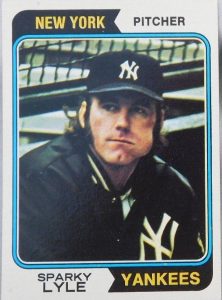George Steinbrenner’s “No Long Hair Or Beard Rule” Is Still Followed

Thurman Munson’s 1976 Topps baseball card shows something you won’t see on any Yankee today, a defiant beard.
At Yankee Stadium’s home opening game on April 11, 1973, the new owner and managing general partner, George M. Steinbrenner III was on hand to see his team. As he watched his players line up along the foul lines and remove their caps for the national anthem, Steinbrenner pulled out an envelope from his suit pocket. He began writing down a series of numbers on the back of the envelope.
After the game the envelope was given to manager Ralph Houk.
“What is this?” Houk wanted to know.
Players who need a haircut was the reply.
Still not knowing any of his players names, Steinbrenner had listed the players numbers who had hair that was not to his liking.
Among the stars on the list were Bobby Murcer, Fritz Peterson, Thurman Munson, Sparky Lyle and Roy White.
Houk posted the list in the locker room and reluctantly informed his hippie players to go to a barber.
Steinbrenner had been perturbed about the long hair since first seeing the Yankees in spring training. Now it was time to do something about it.
This incident marked the beginning of George Steinbrenner’s 37 year odyssey of interference and unpredictability as owner of the Yankees.
To Steinbrenner, short hair and being clean shaven represented order and discipline. No one mentioned to Steinbrenner that baseball was not the military.
Mike Burke, part owner and president of the Yankees, had very long hair himself. Burke was not very concerned about Steinbrenner’s meddling and downplayed the hair cutting incident.

NEW YORK – JANUARY 3, 1973 Yankees President Michael Burke & George Steinbrenner at press conference at Yankee Stadium where the announcement is made that an ownership group led by Steinbrenner are the new owners of the Yankees. (Photo by: Olen Collection/Diamond Images/Getty Images)
Burke, who had been Yankee president since 1966, was instrumental in putting the deal together for Steinbrener and his 13 limited partners, to buy the Yankees from CBS. Burke was led to believe he would be considered a co-partner on an equal level with Steinbrenner.
When Steinbrenner spoke to the press on January 3, 1973 , he said he would be an absentee owner and Burke would run the team. “We’re not going to pretend we’re something we aren’t. I’ll stick to building ships.”
Burke should have more concerned about Steinbrenner’s controlling behavior and desire to be solely in charge. Soon after the haircut incident, Steinbrenner started firing off memos left and right asserting his control of the team. Less than 3 weeks after opening day, Burke resigned. The truth was Burke had been forced out as president of the Yankees and later gave up his ownership stake.
Yankee Third baseman Graig Nettles asked with a straight face, “Was his hair too long?” Continue reading









